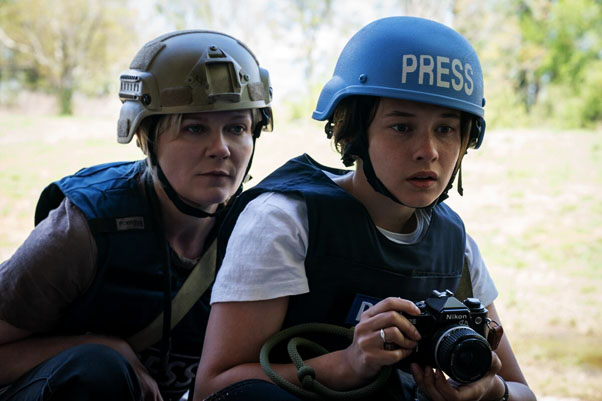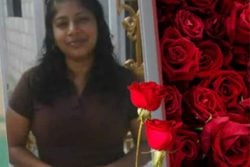 There’s an allure to ambiguity in art that A24’s “Civil War” constantly seems aware of. It’s there in the emotional gaps of the characters’ intentions. It’s also there in the way the camera moves unemotionally through the war-torn landscape of a dystopian America where an authoritarian and third-term US President is battling various insurgent regional factions. Ambiguity, when effective, challenges audiences to recognise multiplicity of meaning in seemingly monolithic concepts. Even when it leaves us uncertain, ambiguity (done well) can illuminate the multitudes of the world in ways that spark thought. But ambiguity feels stultifying when the vagueness of its effect seems like a deflection from art that is, itself, largely empty of risk or argument. The propulsive sounds of carnage, and the haunting stretches of silence, in “Civil War” are impressively deployed by sound designer Glenn Freemantle (the film’s MVP). But the actual film is jarringly sterile beneath the sound and fury.
There’s an allure to ambiguity in art that A24’s “Civil War” constantly seems aware of. It’s there in the emotional gaps of the characters’ intentions. It’s also there in the way the camera moves unemotionally through the war-torn landscape of a dystopian America where an authoritarian and third-term US President is battling various insurgent regional factions. Ambiguity, when effective, challenges audiences to recognise multiplicity of meaning in seemingly monolithic concepts. Even when it leaves us uncertain, ambiguity (done well) can illuminate the multitudes of the world in ways that spark thought. But ambiguity feels stultifying when the vagueness of its effect seems like a deflection from art that is, itself, largely empty of risk or argument. The propulsive sounds of carnage, and the haunting stretches of silence, in “Civil War” are impressively deployed by sound designer Glenn Freemantle (the film’s MVP). But the actual film is jarringly sterile beneath the sound and fury.
The journalists are our protagonists in this world. We spend most of the film with four of them. Lee (Kirsten Dunst) is our frame of reference for this world. She is a renowned war-photographer in this dystopian future. So renowned that a budding photographer Jessie (Cailee Spaeny) recognises her immediately when the two meet, by chance, during a protest than turns deadly and Lee saves Jessie from a suicide-bomb explosion. Lee and her colleague Joel (Wagner Moura) and a journalist from Reuters, are travelling from Brooklyn to the White House to interview the president whose hold on a factious America is weakening. Sammy, a veteran journalist for the New York Times, adds a note of distinguished ceremony to the quartet played with the wizened grace of Stephen McKinley Henderson. But for a film so nominally preoccupied with journalism, and the dissemination of information, “Civil War” is startlingly absent of context and nuance.
Kirsten Dunst and Cailee Spaeny in “Civil War”
The early sequences offer questions that are, at first, intriguing for what they may suggest and what we expect the film to eventually interrogate. The chaos of the civil war means that a short journey from Brooklyn to the White House must now take days as the quartet, travelling in a van labelled ‘Press’, seek to find safer alternate routes. When they stop at a gas station to fill their tank, the gun-toting men who are guarding it are an immediate sign that things are in disarray in this America and in a moment of sharp tension, Lee takes a photo of one of the men flanked by two badly beaten looters. The moment is sharp, the conversation – and the entire film – which come afterwards are less so.
Alex Garland, both director and writer, positions Lee as the closest thing to a voice of reason in the film. He cleverly avoids establishing how much of her hardened curtness is sensible practicality and how much is a jaded trauma response, although it’s a dynamic that leaves Dunst performances hitting a limit of expressiveness as the film goes on. As Jessie recovers from her head-to-head encounters with the gun-toting men, she finds herself panicking and questioning her reaction. Lee interrupts her spiralling with a moment that soon feels like a meta-commentary on “Civil War” itself: “Once you start asking yourself those questions, you can’t stop. So, we don’t ask. We record so other people ask. You wanna be a journalist, that’s the job.”
Removed from the context of the film it’s a familiar, if not quite accurate, positioning of journalism. Lee’s insight into her work gives her a damning passivity that places her at home with familiar contemporary journalists of our own world. The idea of journalism as a profession where objectivity is a heroic apex to aspire for, and where human emotional responses are a liability is familiar, if absurd. It’s a parallel I can make because of my own historical positionality with hard-news journalism, especially in a country where a defanged media conglomerate is often encouraged to objectively report what powerful people say without contextualisation. Each time I picked up a video camera to record something for a newscast, I picked it up with the awareness that what I chose to focus on came with its own choices and biases. What story was I trying to tell? But journalism that serves to document without interrogation is journalism absent of meaning. It is instructive that Garland structures the film, the camerawork conjuring a mood of worn verité, as journalism. And like Lee’s idea of journalism, it documents but it does not interrogate.
What does it mean for a film where we spend most of its runtime with four journalists and can discern nothing about their own relationship with the world around them? What do they think about the world they drive through? Do they think at all? Do they feel? It’s an absence of anything beneath the surface that is startling to observe. There are no real people here, merely camera-toting avatars. Jessie is built in the image of Lee, the girl that she was. Joel’s bloodlust is suggested in certain moments, and then abandoned in others, as he seems to find thrill in being close to death during coverage of a shootout, but these are moments that feel more dutiful than exacting. When Lee and Jessie bond about their families, avoiding the tensions of the war in farms in western parts of the country, the conversation only feigns at engaging with these characters as people and it emphasises Garland’s own inability to imagine the reality of this world beyond the idea of it.
A common critical support of the emotional and political absence of “Civil War” has been the potential it holds in problematising depictions of war-torn countries by American filmmakers and journalists. Finally, one might say, a world where a crisis in America is as indistinctly represented as the carnage abroad. But it’s an argument that feels hollow, or at least flat-footed if that is a thought Garland attaches any kind of artistic legibility to. Garland’s own Britishness, in relation to the Americana of the world, might offer some insight if the characters were similarly removed. In fact, a version of “Civil War” where the arbiters of the information were all international journalists might offer something searing, and provocative, in the query of who decides what is, or isn’t represented in the media.
But with the Americanness of each of the four main principal characters written so indelibly and then never examined, Garland’s conceptualisation of them feels effete when the film seems unable to identify what keeps them alive, and in this industry, amidst so much wreckage. Have they reached a level of weariness to the realities of the world because of what has happened? I’m not sure, but I’m also not sure Alex Garland knows. Or cares. But caring would interrupt the illusion of objectivity “Civil War” is prideful of.
The idea of journalism in a dystopia is short-changed when Garland is unable to limn the interiority of its characters to any great effect. An early conversation with Jessie establishes that Lee rose to fame after her images of “The ANTIFA Massacre”.
This suggests some thought on the construction of the world, but little in the film feels considered beyond the surface. Even if we imagine Lee as jaded in her career, her approach to her work feels muddled and confusing. She and Joel insist on travelling to DC to interview the president, despite reports that journalists have been shot on the lawns of the White House. We are meant to find their willingness to find the story fearless, but I find myself confused as to the dynamics of journalism in this future. Who are their editors? Who are their audiences? Americans? The international community? What story are they trying to tell and why? Neither character can answer that question when they go through the film absent of character motivations that can offer any context of who they are, or why. Neither can the film when its production design feels unrealised in the context of a dystopian future.
The indistinction in “Civil War” hangs over every fabric of the film, not just its characters. Lee and Jessie take photos with analog cameras, which certainly offer more mileage for cinematic symbolism but feel ignorant of how technology might affect a futuristic dystopia.
The inability of “Civil War” to consider how technology has affected media not just in the future but in our very precarious present reveals a filmmaker more interested in signifiers as a means to an end, rather than with engaging with his subjects in any good faith. In our current reality, the world watches a genocide of Brown people in the Gaza Strip and a tragic civil war in Sudan not just through journalistic images and TV screens. We watch it through cell-phone footage, tweets, and Instagram. Elsewhere, superpowers are deploying drones both as weapons of destruction and as tools of surveillance. In “Civil War” we have men armed with guns and journalists armed with analog cameras. There are indications that Alex Garland, both writer and director of “Civil War”, imagines his dystopian film as a kind of fearless anatomy of a zeitgeist, but it’s an unrealised attempt when the film seems unable to imagine its world through the lens of our own technological reality.
Rob Hardy’s cinematography gains a lot of mileage out of moments where the black-and-white photos of Lee, and then Jessie, are stitched into the diegesis of the film offering a pointed juxtaposition of the “reality” with their self-serious images. It’s a tool that offers potential avenues of thought that would mean something were the film to engage with the artistic appeal of the world vis-à-vis the colour of carnage in the real world. But it’s a dynamic I find “Civil War” unable to navigate when it is relentlessly content to offer searing depictions of violence and tension but hesitates to risk anything by commenting on it in any meaningful way. The apolitical stance is not an inherent demerit, but too much of “Civil War” seems to relish in absence – of context, of nuance, of personality. It’s unsurprising that persons from different factions have their own interpretation of “Civil War”, each with a certainty of where its allegiance lies. In the absence of any discernible meaning, we are compelled to create our own. But, if you hedge your bets to that extent, you end up with a film like “Civil War” that is absent of meaning.
By its end, those absences seem like attempts to avoid risk by offering little context. Lee is afraid to ask questions because of the answers that might unsettle her. In “Civil War” Garland avoids interrogation of his grim images, only establishing an aggrandising remove from the story punctuated with needle-drops that interrupt any emotional acuity of the characters. There’s no artistic power in ambiguity dependent on absence like that. Only fecklessness.
Civil War is playing in local cinemas





